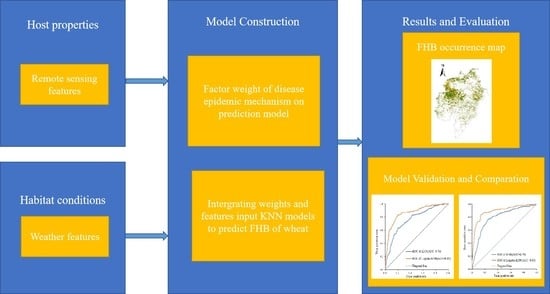Combining Disease Mechanism and Machine Learning to Predict Wheat Fusarium Head Blight
Abstract
1. Introduction
2. Materials and Methods
2.1. Study Area and Data
2.2. Construction of a Remote Sensing Prediction Model of Wheat FHB
2.2.1. Selection of Disease Prediction Factors
2.2.2. The Factor Weight of the Disease Epidemic Mechanism in the Prediction Model Was Expressed Quantitatively
2.2.3. Prediction of Wheat FHB with KNN Coupled with the Logistic Mechanism-Based Model
3. Results
3.1. Selection of Remote Sensing-Based Disease Prediction Factors of Wheat FHB
3.2. Quantitative Expression of the Weight of the Prediction Model Based on the Logistic Mechanism-Based Model
3.3. Remote Sensing-Based Prediction of Wheat FHB
4. Discussion
5. Conclusions
Author Contributions
Funding
Conflicts of Interest
References
- Dweba, C.C.; Figlan, S.; Shimelis, H.A.; Motaung, T.E.; Sydenham, S.; Mwadzingeni, L.; Tsilo, T.J. Fusarium head blight of wheat: Pathogenesis and control strategies. Crop Prot. 2017, 91, 114–122. [Google Scholar] [CrossRef]
- Jia, H.; Zhou, J.; Xue, S.; Li, G.; Yan, H.; Ran, C.; Zhang, Y.; Shi, J.; Jia, L.; Wang, X.; et al. A journey to understand wheat Fusarium head blight resistance in the Chinese wheat landrace Wangshuibai. Crop J. 2018, 6, 48–59. [Google Scholar] [CrossRef]
- Wegulo, S.N.; Baenziger, P.S.; Nopsa, J.H.; Bockus, W.W.; Hallen-Adams, H. Management of Fusarium head blight of wheat and barley. Crop Prot. 2015, 73, 100–107. [Google Scholar] [CrossRef]
- Ma, H.; Zhang, X.; Yao, J.; Cheng, S. Breeding for the resistance to Fusarium head blight of wheat in China. Front. Agric. Sci. Eng. 2019, 6, 251–264. [Google Scholar]
- Shah, L.; Ali, A.; Yahya, M.; Zhu, Y.; Wang, S.; Si, H.; Rahman, H.; Ma, C. Integrated control of fusarium head blight and deoxynivalenol mycotoxin in wheat. Plant Pathol. 2018, 67, 532–548. [Google Scholar] [CrossRef]
- Chen, Y.; Zhang, A.F.; Gao, T.C.; Zhang, Y.; Wang, W.X.; Ding, K.J.; Chen, L.; Sun, Z.; Fang, X.Z.; Zhou, M.G. Integrated use of pyraclostrobin and epoxiconazole for the control of Fusarium head blight of wheat in Anhui Province of China. Plant Dis. 2012, 96, 1495–1500. [Google Scholar] [CrossRef]
- Guo, X.; Wang, M.T.; Zhang, G.Z. Prediction model of meteorological grade of wheat stripe rust in winter-reproductive area, Sichuan Basin, China. Ying Yong Sheng Tai Xue Bao = J. Appl. Ecol. 2017, 28, 3994–4000. [Google Scholar]
- Rodríguez-Moreno, V.M.; Jiménez-Lagunes, A.; Estrada-Avalos, J.; Mauricio-Ruvalcaba, J.E.; Padilla-Ramírez, J.S. Weather-data-based model: An approach for forecasting leaf and stripe rust on winter wheat. Meteorol. Appl. 2020, 27, e1896. [Google Scholar] [CrossRef]
- El Jarroudi, M.; Kouadio, L.; Bock, C.H.; El Jarroudi, M.; Junk, J.; Pasquali, M.; Maraite, H.; Delfosse, P. A threshold-based weather model for predicting stripe rust infection in winter wheat. Plant Dis. 2017, 101, 693–703. [Google Scholar] [CrossRef]
- Zhang, J.; Yuan, L.; Nie, C.; Wei, L.; Yang, G. Forecasting of powdery mildew disease with multi-sources of remote sensing information. In Proceedings of the 2014 The Third International Conference on Agro-Geoinformatics, Beijing, China, 11–14 August 2014; pp. 1–5. [Google Scholar]
- Li, X.; Yang, C.; Huang, W.; Tang, J.; Tian, Y.; Zhang, Q. Identification of cotton root rot by multifeature selection from sentinel-2 images using random forest. Remote Sens. 2020, 12, 3504. [Google Scholar] [CrossRef]
- Bajwa, S.G.; Rupe, J.C.; Mason, J. Soybean disease monitoring with leaf reflectance. Remote Sens. 2017, 9, 127. [Google Scholar] [CrossRef]
- Xiao, Y.; Dong, Y.; Huang, W.; Liu, L.; Ma, H.; Ye, H.; Wang, K. Dynamic remote sensing prediction for wheat fusarium head blight by combining host and habitat conditions. Remote Sens. 2020, 12, 3046. [Google Scholar] [CrossRef]
- Li, W.; Huang, W.; Dong, Y.; Chen, H.; Wang, J.; Shan, J. Estimation on winter wheat scab based on combination of temperature, humidity and remote sensing vegetation index. Trans. Chin. Soc. Agric. Eng. 2017, 33, 203–210. [Google Scholar]
- Li, W.; Liu, Y.; Chen, H.; Zhang, C.C. Estimation model of winter wheat disease based on meteorological factors and spectral information. Food Prod. Process. Nutr. 2020, 2, 5. [Google Scholar] [CrossRef]
- Khalili, E.; Kouchaki, S.; Ramazi, S.; Ghanati, F. Machine learning techniques for soybean charcoal rot disease prediction. Front. Plant Sci. 2020, 11, 2009. [Google Scholar] [CrossRef] [PubMed]
- Marin, D.B.; Santana, L.S.; Barbosa, B.D.S.; Barata, R.A.P.; Osco, L.P.; Ramos, A.P.M.; Guimarães, P.H.S. Detecting coffee leaf rust with UAV-based vegetation indices and decision tree machine learning models. Comput. Electron. Agric. 2021, 190, 106476. [Google Scholar] [CrossRef]
- Shah, D.A.; Molineros, J.E.; Paul, P.A.; Willyerd, K.T.; Madden, L.V.; De Wolf, E.D. Predicting Fusarium head blight epidemics with weather-driven pre-and post-anthesis logistic regression models. Phytopathology 2013, 103, 906–919. [Google Scholar] [CrossRef] [PubMed]
- Kirtphaiboon, S.; Humphries, U.; Khan, A.; Yusuf, A. Model of rice blast disease under tropical climate conditions. Chaos Solitons Fractals 2021, 143, 110530. [Google Scholar] [CrossRef]
- Henderson, D.; Williams, C.J.; Miller, J.S. Forecasting late blight in potato crops of southern Idaho using logistic regression analysis. Plant Dis. 2007, 91, 951–956. [Google Scholar] [CrossRef]
- Rudin, C. Stop explaining black box machine learning models for high stakes decisions and use interpretable models instead. Nat. Mach. Intell. 2019, 1, 206–215. [Google Scholar] [CrossRef] [PubMed]
- Papastamati, K.; van den Bosch, F. The sensitivity of the epidemic growth rate to weather variables, with an application to yellow rust on wheat. Phytopathology 2007, 97, 202–210. [Google Scholar] [CrossRef][Green Version]
- HarDIan, J.M. A logistic model simulating environmental changes associated with the growth of populations of rice weevils, Sitophilus oryzae, reared in small cells of wheat. J. Appl. Ecol. 1978, 15, 65–87. [Google Scholar] [CrossRef]
- Shan, C.; Wang, W.; Liu, C.; Sun, Y.; Hu, Q.; Xu, X.; Tian, Y.; Zhang, H.; Morino, L.; Griffith, D.W.T.; et al. Regional CO emission estimated from ground-based remote sensing at Hefei site, China. Atmos. Res. 2019, 222, 25–35. [Google Scholar] [CrossRef]
- Liu, L.; Dong, Y.; Huang, W.; Du, X.; Ren, B.; Huang, L.; Zheng, Q.; Ma, H. A disease index for efficiently detecting wheat fusarium head blight using sentinel-2 multispectral imagery. IEEE Access 2020, 8, 52181–52191. [Google Scholar] [CrossRef]
- Chen, Y.; Yang, X.; Gu, C.Y.; Zhang, A.F.; Gao, T.C.; Zhou, M.G. Genotypes and phenotypic characterization of field Fusarium asiaticum isolates resistant to carbendazim in Anhui Province of China. Plant Dis. 2015, 99, 342–346. [Google Scholar] [CrossRef]
- Huang, L.; Li, T.; Ding, C.; Zhao, J.; Zhang, D.; Yang, G. Diagnosis of the severity of Fusarium head blight of wheat ears on the basis of image and spectral feature fusion. Siensors 2020, 20, 2887. [Google Scholar] [CrossRef]
- Ren, S.; Chen, X.; An, S. Assessing plant senescence reflectance index-retrieved vegetation phenology and its spatiotemporal response to climate change in the Inner Mongolian Grassland. Int. J. Biometeorol. 2017, 61, 601–612. [Google Scholar] [CrossRef]
- Hatfield, J.L.; Prueger, J.H. Value of using different vegetative indices to quantify agricultural crop characteristics at different growth stages under varying management practices. Remote Sens. 2010, 2, 562–578. [Google Scholar] [CrossRef]
- Zhang, Z.; Liu, M.; Liu, X.; Zhou, G. A new vegetation index based on multitemporal Sentinel-2 images for discriminating heavy metal stress levels in rice. Sensors 2018, 18, 2172. [Google Scholar] [CrossRef]
- Guo, A.; Huang, W.; Dong, Y.; Ye, H.; Ma, H.; Liu, B.; Wu, W.; Ren, Y.; Ruan, C.; Geng, Y. Wheat yellow rust detection using UAV-based hyperspectral technology. Remote Sens. 2021, 13, 123. [Google Scholar] [CrossRef]
- Wu, C.; Niu, Z.; Tang, Q.; Huang, W. Estimating chlorophyll content from hyperspectral vegetation indices: Modeling and validation. Agric. For. Meteorol. 2008, 148, 1230–1241. [Google Scholar] [CrossRef]
- Ren, Y.; Huang, W.; Ye, H.; Zhou, X.; Ma, H.; Dong, Y.; Shi, Y.; Geng, Y.; Huang, Y.; Jiao, Q. Quantitative identification of yellow rust in winter wheat with a new spectral index: Development and validation using simulated and experimental data. Int. J. Appl. Earth Obs. Geoinf. 2021, 102, 102384. [Google Scholar] [CrossRef]
- Gilbert, J.; Haber, S. Overview of some recent research developments in Fusarium head blight of wheat. Can. J. Plant Pathol. 2013, 35, 149–174. [Google Scholar] [CrossRef]
- Xiangxiang, W.; Quanjiu, W.; Jun, F.; Lijun, S.; Xinlei, S. Logistic model analysis of winter wheat growth on China’s Loess Plateau. Can. J. Plant Sci. 2014, 94, 1471–1479. [Google Scholar] [CrossRef]
- King, E.N.; Ryan, T.P. A preliminary investigation of maximum likelihood logistic regression versus exact logistic regression. Am. Stat. 2002, 56, 163–170. [Google Scholar] [CrossRef]
- Tonidandel, S.; LeBreton, J.M. Determining the relative importance of disease prediction factors in logistic regression: An extension of relative weight analysis. Organ. Res. Methods 2010, 13, 767–781. [Google Scholar] [CrossRef]
- Owen, A.B.; Roediger, P.A. The sign of the logistic regression coefficient. Am. Stat. 2014, 68, 297–301. [Google Scholar] [CrossRef]
- de Souza, J.C.S.; Assis, T.M.L.; Pal, B.C. Data compression in smart distribution systems via singular value decomposition. IEEE Trans. Smart Grid 2015, 8, 275–284. [Google Scholar] [CrossRef]
- Menard, S. Six approaches to calculating standardized logistic regression coefficients. Am. Stat. 2004, 58, 218–223. [Google Scholar] [CrossRef]
- Uddin, S.; Haque, I.; Lu, H.; Moni, M.A.; Gide, E. Comparative performance analysis of K-nearest neighbour (KNN) algorithm and its different variants for disease prediction. Sci. Rep. 2022, 12, 6256. [Google Scholar] [CrossRef]
- Noola, D.A.; Basavaraju, D.R. Corn leaf image classification based on machine learning techniques for accurate leaf disease detection. Int. J. Electr. Comput. Eng. 2022, 12, 2088–8708. [Google Scholar] [CrossRef]
- Huang, Y.; Zhang, J.; Zhang, J.; Yuan, L.; Zhou, X.; Xu, X.; Yang, G. Forecasting Alternaria Leaf Spot in Apple with Spatial-Temporal Meteorological and Mobile Internet-Based Disease Survey Data. Agronomy 2022, 12, 679. [Google Scholar] [CrossRef]
- Mendigoria, C.H.; Concepcion, R.; Bandala, A.; Alajas, O.J.; Aquino, H.; Dadios, E. OryzaNet: Leaf Quality Assessment of Oryza sativa Using Hybrid Machine Learning and Deep Neural Network. In Proceedings of the 2021 IEEE 13th International Conference on Humanoid, Nanotechnology, Information Technology, Communication and Control, Environment, and Management (HNICEM), Manila, Philippines, 28–30 November 2021; pp. 1–6. [Google Scholar]
- Ruan, C.; Dong, Y.; Huang, W.; Huang, L.; Ye, H.; Ma, H.; Guo, A.; Ren, Y. Prediction of Wheat Stripe Rust Occurrence with Time Series Sentinel-2 Images. Agriculture 2021, 11, 1079. [Google Scholar] [CrossRef]
- Kaabneh, K.; Tarawneh, H. Dynamic Tomato Leaves Disease Detection using Histogram-based K-means Clustering Algorithm with Back-Propagation Neural Network. In Proceedings of the 2021 22nd International Arab Conference on Information Technology (ACIT), Muscat, Oman, 21–23 December 2021; pp. 1–5. [Google Scholar]
- Arlot, S.; Celisse, A. A survey of cross-validation procedures for model selection. Stat. Surv. 2010, 4, 40–79. [Google Scholar] [CrossRef]
- Weng, S.; Han, K.; Chu, Z.; Zhu, G.; Liu, C.; Zhu, Z.; Zhang, Z.; Zheng, L.; Huang, L. Reflectance images of effective wavelengths from hyperspectral imaging for identification of Fusarium head blight-infected wheat kernels combined with a residual attention convolution neural network. Comput. Electron. Agric. 2021, 190, 106483. [Google Scholar] [CrossRef]
- Prandini, A.; Sigolo, S.; Filippi, L.; Battilani, P.; Piva, G. Review of predictive models for Fusarium head blight and related mycotoxin contamination in wheat. Food Chem. Toxicol. 2009, 47, 927–931. [Google Scholar] [CrossRef] [PubMed]
- Zhu, Z.; Chen, L.; Zhang, W.; Yang, L.; Zhu, W.; Li, J.; Liu, Y.; Tong, H.; Fu, L.; Liu, J.; et al. Genome-wide association analysis of Fusarium head blight resistance in Chinese elite wheat lines. Front. Plant Sci. 2020, 11, 206. [Google Scholar] [CrossRef]
- Ma, H.; Huang, W.; Dong, Y.; Liu, L.; Guo, A. Using UAV-Based Hyperspectral Imagery to Detect Winter Wheat Fusarium Head Blight. Remote Sens. 2021, 13, 3024. [Google Scholar] [CrossRef]
- Qiu, M.; Zheng, S.; Tang, L.; Hu, X.; Xu, Q.; Zheng, L.; Weng, S. Raman Spectroscopy and Improved Inception Network for Determination of FHB-Infected Wheat Kernels. Foods 2022, 11, 578. [Google Scholar] [CrossRef]
- Borrellas, P.; Unceta, I. The Challenges of Machine Learning and Their Economic Implications. Entropy 2021, 23, 275. [Google Scholar] [CrossRef]
- Gao, X.; Li, G. A KNN model based on manhattan distance to identify the SNARE proteins. IEEE Access 2020, 8, 112922–112931. [Google Scholar] [CrossRef]
- Ma, C.; Du, X.; Cao, L. Improved KNN Algorithm for Fine-Grained Classification of Encrypted Network Flow. Electronics 2020, 9, 324. [Google Scholar] [CrossRef]
- Zhang, S.; Li, X.; Zong, M.; Zhu, X.; Wang, R. Efficient kNN classification with different numbers of nearest neighbors. IEEE Trans. Neural Netw. Learn. Syst. 2017, 29, 1774–1785. [Google Scholar] [CrossRef] [PubMed]
- Pujari, M.; Awati, C.; Kharade, S. Efficient Classification with an Improved Nearest Neighbor Algorithm. In Proceedings of the 2018 Fourth International Conference on Computing Communication Control and Automation (ICCUBEA), Pune, India, 16–18 August 2018; pp. 1–5. [Google Scholar]
- Shan, Y.; Li, S.; Li, F.; Cui, Y.; Li, S.; Chen, M.; He, X. A density peaks clustering algorithm with sparse search and Kd tree. arXiv 2022, arXiv:2203.00973. [Google Scholar]
- Chen, Y.; Zhou, L.; Tang, Y.; Singh, J.P.; Bouguila, N.; Wang, C.; Wang, C.; Du, J. Fast neighbor search by using revised kd tree. Inf. Sci. 2019, 472, 145–162. [Google Scholar] [CrossRef]
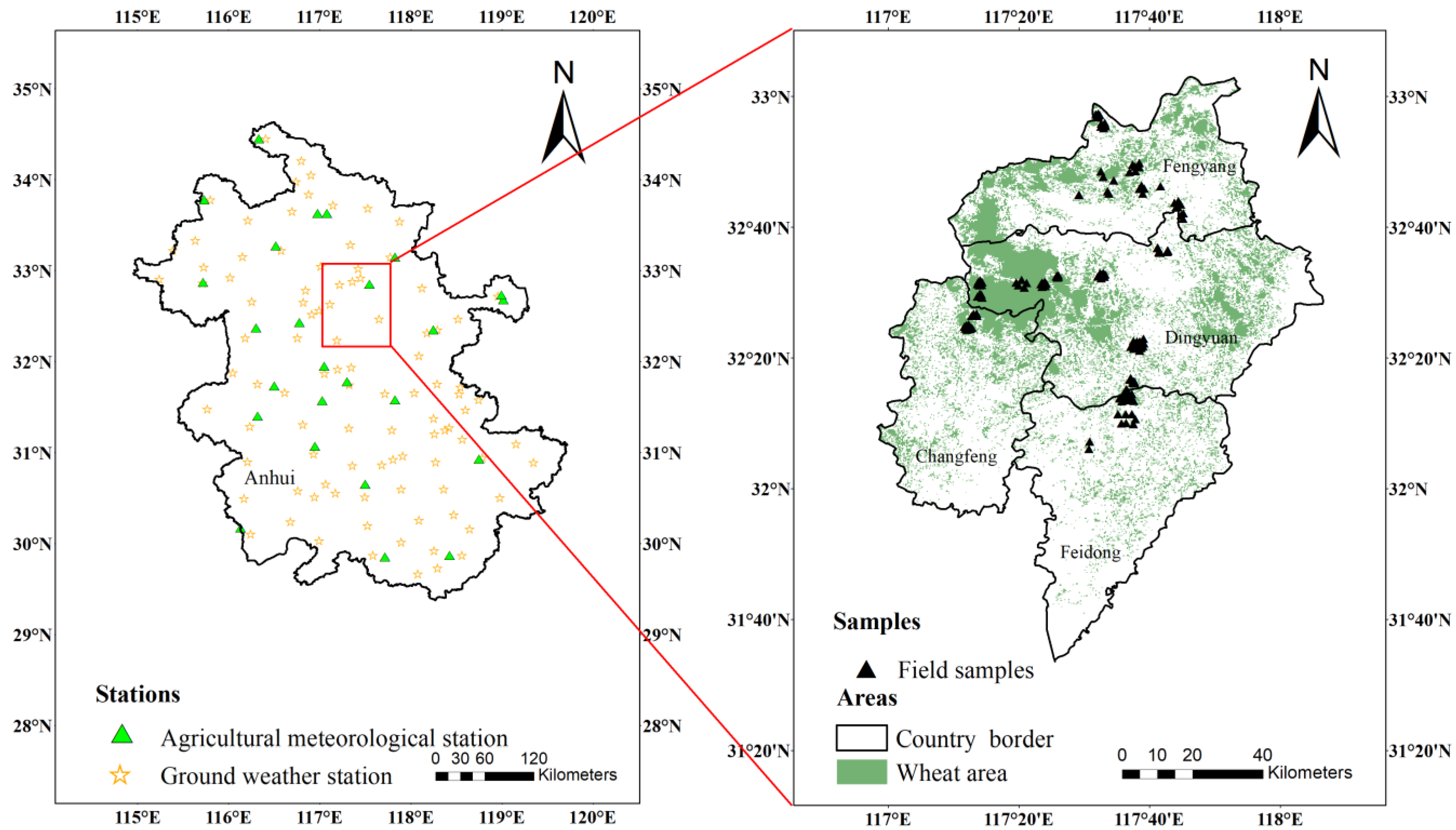
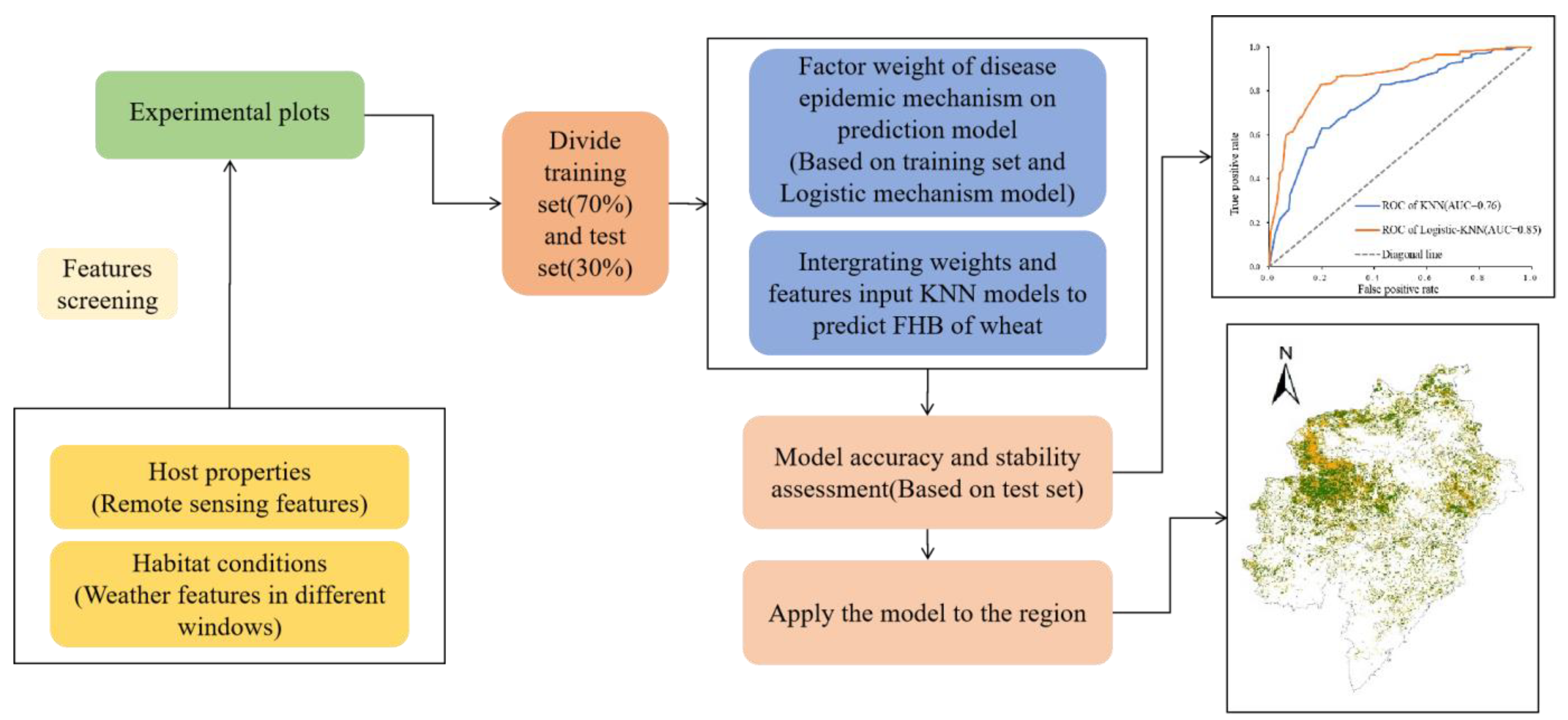
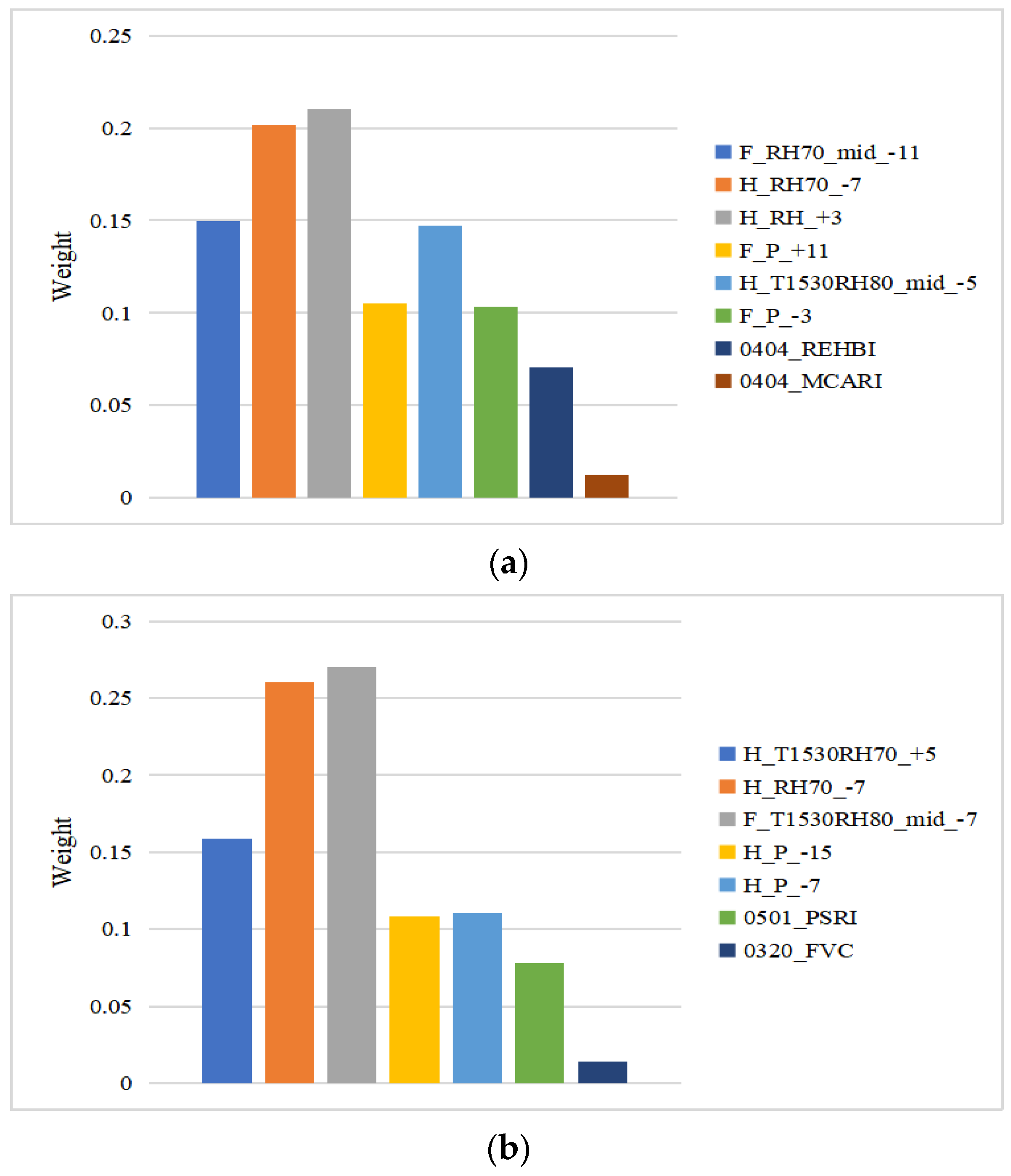
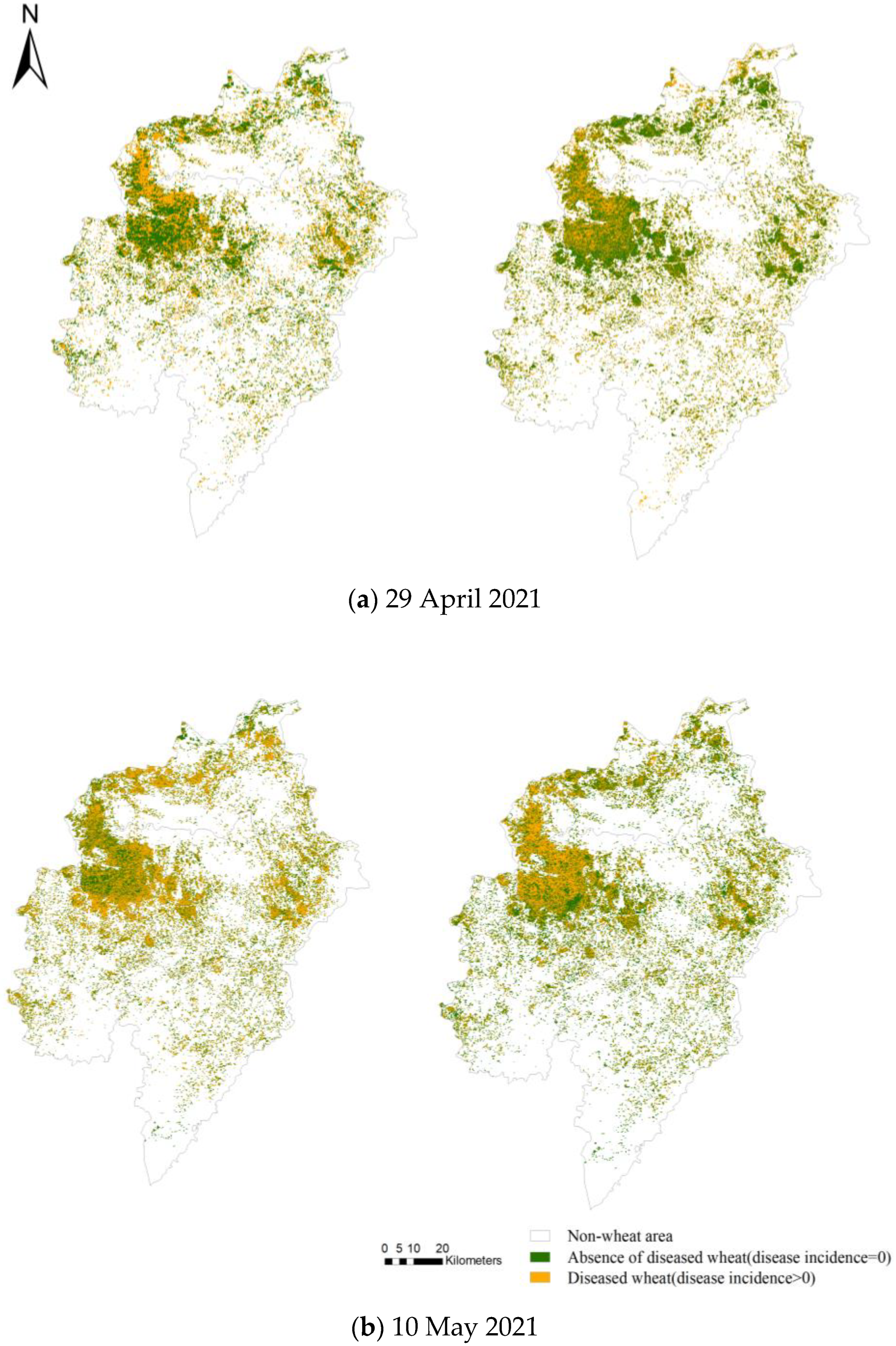
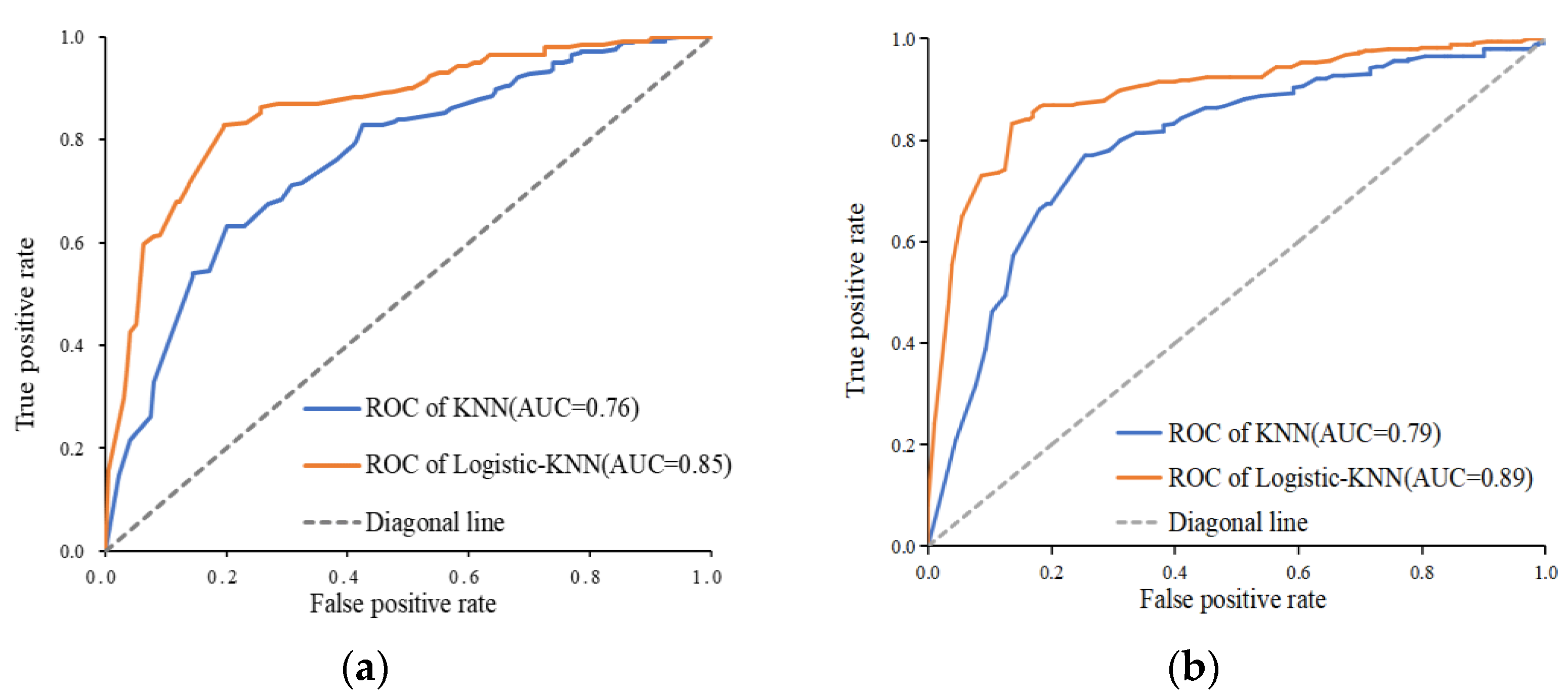
| Index | Definition |
|---|---|
| F_RH70_mid_-11 | The number of days with RH greater than 70% in the 11 days before and after flowering |
| H_RH70_-7 | The number of days with RH greater than 70% in the 7 days before heading |
| H_RH_+3 | The average RH in the 3 days after heading |
| F_P_+11 | The average precipitation of the 11 days after flowering |
| H_T1530RH80_mid_-5 | The number of days with temperature between 15 and 30 °C degrees and RH greater than 80% in the 5 days before and after heading |
| F_P_-3 | The average precipitation during the first three days of flowering |
| 0404_REHBI | Red-edge head blight index on 4 April 2021 |
| 0404_MCARI | Modified chlorophyll absorption ratio on 4 April 2021 |
| Index | Definition |
|---|---|
| H_T1530RH70_+5 | The number of days with temperatures between 15 and 30 °C degrees and RH greater than 70% in the 5 days after heading |
| H_RH70_-7 | The number of days with RH greater than 70% in the 7 days before heading |
| F_T1530RH80_mid_-7 | The number of days with temperatures between 15 and 30 °C degrees and RH greater than 80% in the 7 days before and after flowering |
| H_P_-15 | The average precipitation of the 15 days before heading |
| H_P_-7 | The average precipitation of the 7 days before heading |
| 0501_PSRI | Plant senescence absorption ratio on 1 May 2021 |
| 0320_FVC | Fractional Vegetation Cover on 20 March 2021 |
| Prediction Model | 29 April 2021 | |
|---|---|---|
| k | Mean Overall Accuracy | |
| Logistic-KNN | 3 | 0.865 |
| Logistic-KNN | 5 | 0.781 |
| Logistic-KNN | 7 | 0.709 |
| Prediction Model | 29 April 2021 | |
|---|---|---|
| Accuracy | F1 Score | |
| Logistic-KNN | 0.88 | 0.86 |
| KNN | 0.75 | 0.68 |
| Prediction Model | 10 May 2021 | |
|---|---|---|
| Accuracy | F1 Score | |
| Logistic-KNN | 0.92 | 0.94 |
| KNN | 0.79 | 0.80 |
Publisher’s Note: MDPI stays neutral with regard to jurisdictional claims in published maps and institutional affiliations. |
© 2022 by the authors. Licensee MDPI, Basel, Switzerland. This article is an open access article distributed under the terms and conditions of the Creative Commons Attribution (CC BY) license (https://creativecommons.org/licenses/by/4.0/).
Share and Cite
Li, L.; Dong, Y.; Xiao, Y.; Liu, L.; Zhao, X.; Huang, W. Combining Disease Mechanism and Machine Learning to Predict Wheat Fusarium Head Blight. Remote Sens. 2022, 14, 2732. https://doi.org/10.3390/rs14122732
Li L, Dong Y, Xiao Y, Liu L, Zhao X, Huang W. Combining Disease Mechanism and Machine Learning to Predict Wheat Fusarium Head Blight. Remote Sensing. 2022; 14(12):2732. https://doi.org/10.3390/rs14122732
Chicago/Turabian StyleLi, Lu, Yingying Dong, Yingxin Xiao, Linyi Liu, Xing Zhao, and Wenjiang Huang. 2022. "Combining Disease Mechanism and Machine Learning to Predict Wheat Fusarium Head Blight" Remote Sensing 14, no. 12: 2732. https://doi.org/10.3390/rs14122732
APA StyleLi, L., Dong, Y., Xiao, Y., Liu, L., Zhao, X., & Huang, W. (2022). Combining Disease Mechanism and Machine Learning to Predict Wheat Fusarium Head Blight. Remote Sensing, 14(12), 2732. https://doi.org/10.3390/rs14122732







